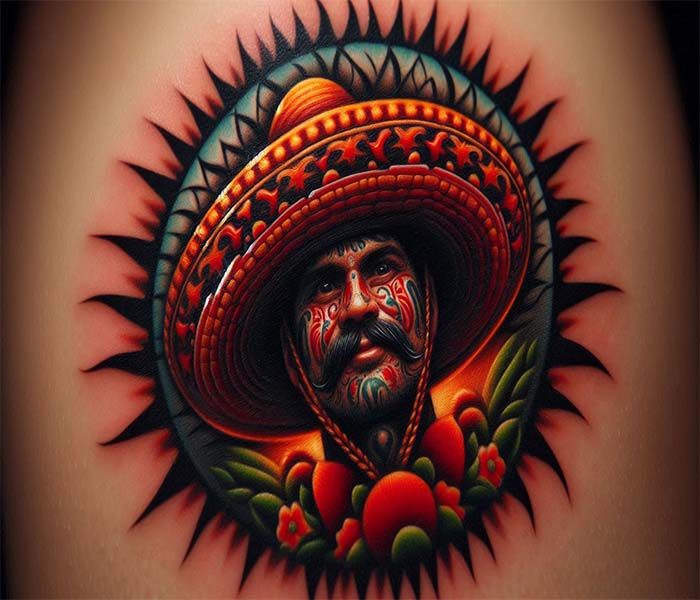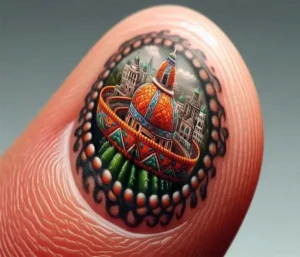Discover why small Mexican tattoos are the perfect choice for personal expression. This in-depth guide explores their cultural symbolism, unique designs, and versatile styles.
Thank you for reading this post, don't forget to subscribe!Introduction: The Allure of Small Mexican Tattoos
Small Mexican tattoos have become a favorite choice for tattoo enthusiasts due to their cultural significance and captivating designs. They embody Mexico’s rich history, diverse folklore, and deep spiritual roots, making each piece a unique statement. Unlike more extensive, more elaborate tattoos, small Mexican tattoos can be simple yet impactful, carrying profound meanings in a minimalist form. Whether you’re looking to honor your heritage, appreciate Mexican culture, or want a stunning design, these tattoos express your identity and values without taking up much space on your body.
Traditional Mexican Tattoo Designs and Their Meanings
Mexican tattoos are symbolic, often depicting life, death, love, and spirituality. Here’s a deeper look at some iconic designs:
- Sugar Skulls (Calaveras): A staple of Día de los Muertos, sugar skull tattoos are vibrant and detailed, representing the connection between the living and the dead. These tattoos are often adorned with flowers, crosses, and intricate patterns, symbolizing the celebration of life and honoring loved ones who have passed away.
- Roses and Marigolds: Roses in Mexican tattoos are commonly associated with love, passion, and beauty. Marigolds, known as the ‘flowers of the dead,’ play a significant role in the Day of the Dead festivities. They are believed to help guide spirits back to the world of the living, making them a powerful symbol of remembrance.
- Aztec Symbols: The Aztec culture is a cornerstone of Mexican history, and its symbols are popular in tattoo art. Designs like the Aztec sunstone (representing time and cosmic order) or the eagle warrior (symbolizing strength and courage) are often chosen for their powerful meanings and intricate designs.
- La Catrina: The iconic elegant skeleton La Catrina is a popular choice for those wanting a tattoo that blends beauty and mortality. Jose Guadalupe Posada created it to symbolize death’s inevitability, regardless of status in life. It’s a reminder to live fully and embrace life’s joys and impermanence.
Choosing the Perfect Small Mexican Tattoo for You
Selecting the right tattoo is a personal decision, especially with the rich cultural symbolism in Mexican designs. Here’s how you can make an informed choice:
- Consider the Cultural Significance: Learn about a design’s history and meaning before choosing it. Mexican tattoos are often tied to sacred traditions and beliefs, so understanding their background will help you connect with your tattoo on a deeper level.
- Match the Design to Your Personality: Are you drawn to sugar skulls’ bold and colorful nature, or do you prefer the strength and resilience depicted in Aztec warrior tattoos? Choose a design that reflects your personality and
- Decide on the Size and Style: Small Mexican tattoos can range from simple, minimalist designs to detailed, intricate artwork. A small rose might look delicate and refined, while a tiny Aztec sun symbol could be more abstract and bold.
- Get Professional Advice: Working with a tattoo artist who understands Mexican culture and symbolism is crucial. An experienced artist can help you modify or customize the design to suit your preferences while preserving its traditional elements.
Best Placements for Small Mexican Tattoos
The placement of your tattoo can significantly influence its impact and visibility. Here are some of the best spots for small Mexican tattoos:
- Wrists and Ankles: These areas are perfect for small, intricate designs. A tiny sugar skull or a delicate rose looks striking on the wrist or ankle, easily showcased but easily covered if needed.
- Behind the Ear: This spot is subtle yet stylish, ideal for smaller symbols like a marigold or a minimalist Aztec icon. It’s a discreet place that adds a touch of mystery and can be hidden behind hair if desired.
- Fingers and Hands: Finger tattoos are popular for those who want to make a bold statement. Miniature roses, skulls, or even a simple cross can be inked on the fingers or hands, showcasing cultural pride visibly.
- Neck and Collarbone: These placements are a bit bolder but can accommodate slightly larger designs while still being small tattoos. An intricate La Catrina on the collarbone or an Aztec sun on the neck can be elegant and powerful.
Mexican Tattoo Trends: Classic vs. Modern Styles
Mexican tattoos have a timeless appeal, but modern interpretations have given them a new twist. Let’s explore these evolving trends:
- Classic Designs: Traditional Mexican tattoos are characterized by vivid colors, bold outlines, and rich symbolism. These designs often include classic elements like the Virgin of Guadalupe, sacred hearts, or vibrant sugar skulls. They are typically detailed and colorful, making a solid visual impact.
- Minimalist and Line Art Tattoos: Today’s trends lean towards a more minimalist approach, especially for small tattoos. Simple line art versions of traditional symbols, like a tiny sugar skull or an outline of La Catrina, offer a contemporary twist while retaining their cultural significance.
- Black-and-grey Realism: This style uses shading to create a lifelike effect, often seen in modern interpretations of La Catrina or Aztec warriors. It’s famous for those seeking a more realistic and detailed tattoo that still honors traditional themes.
- Fusion Tattoos: Some people prefer to blend traditional Mexican designs with modern elements, creating unique, customized tattoos. For example, combining a classic rose with geometric shapes or incorporating Aztec symbols into a more abstract design offers a personalized take on Mexican tattoo art.
Caring for Your Small Mexican Tattoo
The healing process is essential for any tattoo, microscopic, detailed patterns. Maintaining your tattoo’s color and sharpness requires proper treatment. Here is what you should do:
- Gently Clean It: Clean your tattoo with warm water and a light soap. Pat it dry with a fresh towel, and avoid strong products that can cause skin irritation.
- Preserve its Hydration: To keep the region hydrated, apply a thin layer of a lotion without fragrance or an ointment designed specifically for tattoos. This will maintain the design’s sharpness and help avoid scabbing.
- Steer clear of the sun: Your tattoo may quickly fade in the sun, particularly while it is healing. To preserve the color of your tattoo once it has healed, keep it covered or apply sunscreen.
- Avoid Itching: Your tattoo may itch while it heals. Avoid picking or scratching at it to prevent damage and ensure the pattern heals correctly.
FAQs
Q. What are Mexican-style tattoos called?
Mexican-style tattoos are often called “Chicano” or “Mexican traditional tattoos.” These tattoos draw inspiration from Mexican culture, folklore, and history. They feature bold lines, vibrant colors, and elements such as sugar skulls, roses, Aztec symbols, and religious icons. The designs are deeply rooted in tradition, often blending aspects of ancient Aztec art with Chicano street art influences.
Q. Which is the most meaningful tattoo?
The most meaningful tattoo varies by individual, but Aztec symbols and sugar skull tattoos are highly significant in Mexican culture. Sugar skulls represent Día de los Muertos, honoring loved ones who have passed. Meanwhile, Aztec tattoos often depict ancient gods, warriors, or sunstone, symbolizing strength, protection, and life cycle. These designs are chosen for their deep historical and spiritual meanings.
Why do Mexicans get Aztec tattoos?
Mexicans often choose Aztec tattoos to celebrate their heritage and honor the powerful legacy of the Aztec civilization. Aztec designs, such as the warrior or sun god, symbolize bravery, strength, and a connection to ancestral roots. These tattoos serve as a tribute to Mexico’s indigenous history, reflecting pride in the cultural achievements and spirituality of the Aztec people.
Q. What does Hamsa tattoo design mean?
A Hamsa tattoo features an open hand with an eye in the center, symbolizing protection, luck, and warding off evil. It is known as a protective talisman in various cultures, including Mexican folk traditions influenced by spiritual beliefs. The Hamsa is believed to bring good fortune and safeguard against negative energy, making it a popular choice for those seeking a meaningful and protective tattoo.
Q. What does a 13 tattoo mean in Mexico?
In Mexico, a tattoo of the number 13 can have multiple meanings. Traditionally, it’s seen as a symbol of rebellion or association with the Mexican Mafia (La Eme), where ‘M’ is the 13th letter of the alphabet. However, outside gang culture, it can also represent overcoming challenges or embracing good fortune, as the number is considered unlucky in many cultures, making it a symbol of defiance.
Q. What is the most famous Aztec symbol?
The most famous Aztec symbol is the Aztec Sun Stone (often called the “Calendar Stone”), representing Aztec cosmology and the cycle of time. It features intricate carvings of the sun god Tonatiuh at its center, surrounded by depictions of the five ages of the world. This symbol embodies the Aztecs’ deep connection to their mythology, the sun, and the universe, making it a popular tattoo choice for its historical and cultural significance.
Conclusion: Embrace the Beauty of Small Mexican Tattoos
A small Mexican tattoo is a meaningful way to express your love for Mexican culture or to stay connected to your roots. Every tattoo has a backstory, whether you choose a traditional sugar skull, a delicate marigold, or a striking Aztec motif. Enjoy the process of incorporating a work of art and history into your life, and take your time selecting a design that appeals to you.
Read more articles on Health and Wellness.
You might like to read:
The Timeless Symbolism of Heart Tattoos: Everything you need to know


